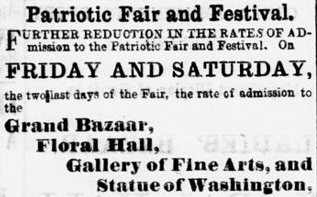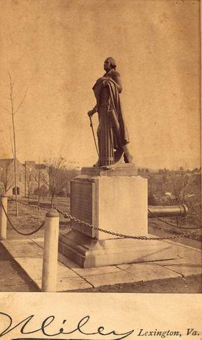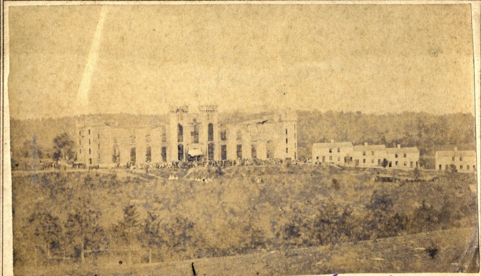A Monumental Controversy
Today, we are pleased to welcome back guest author Jon-Erik Gilot

The past few weeks have renewed a discussion – or shouting match – relating to the place and context of both Confederate and historical iconography currently dotting our parks and cityscapes. While this conversation has exploded following the tragic events in Charlottesville, it has a history as old as the Civil War itself. As such we may do well to examine what may be the first “monumental controversy” of the Civil War.
Fresh off a resounding victory at the Battle of Piedmont, the ever-controversial General David “Black Dave” Hunter and his command of approximately 18,000 Federal troops entered Lexington, Virginia on June 11, 1864. Hunter would take two days in Lexington to consolidate his troops but made the most of his short stay by burning the home of former Virginia Governor John Letcher and reducing the Virginia Military Institute to a smoking hull. He would state matter-of-factly in his official report that “on the 12th I also burned the Virginia Military Institute and all the buildings connected with it.”[i] As the Confederates would reoccupy Lexington in Hunter’s wake, hospital steward John Apperson noted in his diary, “…the sad spectacle of the gloating destruction of the enemy is seen. The bare walls of V.M.I. call for a stern and unflinching position.”[ii]
Escaping destruction during the shelling and fire of the VMI barracks was a bronze statue of George Washington, a copy of the highly regarded statue by French sculptor Jean-Antonie Houdon. While the original was completed in 1792, the VMI copy was cast more than sixty years later in Richmond, Virginia by William James Hubard and erected on the campus in 1856. Believed to be the first bronze statue of Washington in the country, it was one of at least six produced in Richmond. Numerous examples of later casts can be found across the United States today, from inside the Washington Monument and Statuary Hall to Los Angeles.
While General Hunter had initially considered sending the statue to the US Military Academy at West Point, Colonel Henry Capehart of the 1st West Virginia Cavalry and several other officers urged General Hunter to send the statue to Wheeling, the capital of the new state of West Virginia. Wheeling was an important terminus for rails, roads, and the Ohio River. Wheeling was firmly inside Union lines and thereby safe from any Confederate reprisal from the burning and theft in Lexington, which apparently wasn’t far from their mind. John Apperson would note in his diary that “An avowal by the first Md. Cav. to burn a college & gubernatorial mansion. May they kept [sic] it.” [iii] Hunter relented and dispatched Company H of the 11th West Virginia to convey the statue and 150 Confederate prisoners through the mountains to Wheeling.
The statue would travel by wagon to Webster, West Virginia where it was placed on the B&O Railroad, arriving in Wheeling on the evening of July 2, 1864, with the Confederate prisoners continuing on to Camp Chase. While a dedicatory bronze tablet accompanying the monument was broken in three pieces during transport, the statue arrived otherwise unharmed. VMI’s 1864 Annual Report would incorrectly report that “being unable to transport this work of art through the mountain passes of Virginia, it was finally broken to pieces and destroyed.” [iv]
Within two days the statue was on exhibition at the Wheeling Sanitary Fair. The fair, lasting one week, drew thousands of visitors with all proceeds earmarked for the benefit of the sick and wounded soldiers cared for in the city by the US Sanitary and Christian Commissions. The statue was displayed with such historical artifacts as a bible printed in 1530, a saw used in the construction of Fort Henry in 1777, and a piano originally owned by Washington himself, as well as such curiosities as a double-headed calf, a six-legged sheep, albino rats, and more.
The Wheeling Daily Intelligencer encouraged readers to, “avail themselves of this opportunity to see him as he appeared in the height of his glory and usefulness,” though in the same issue the paper decried the theft of the monument, comparing General Hunter to Napoleon, who “robbed the great galleries of Italy, stripping even the monasteries and churches…of their works of art.”[v] The Wheeling Daily Register, a staunchly pro-Democratic paper, likewise condemned the theft of the statue and railed against Hunter in consecutive issues, regarding the theft as, “without parallel in modern times.”[vi] Hunter took offense to the Register’s damning editorials and had the paper’s editors placed in the Athenaeum, a Wheeling prison used to house Confederate soldiers and political prisoners. The doors to the paper were shuttered for nearly eight weeks, while its editors would decry their treatment at the hands of General Hunter for years following the war.
At the conclusion of the Sanitary Fair the statue was placed on the grounds of the Linsly Institute, then serving as the West Virginia Statehouse. By February 1865 the elements had taken their toll on the statue. The “sulphurous atmosphere” of the nearby roundhouse and railyard coated the statue, making it appear, “more like the sign of a tobacco store than a statue of the “Father of his Country” so much so that “no one who saw the statue when it was first brought to the city would now recognize it as the same piece of workmanship.” [vii]

With VMI set to reopen in October 1865, The Richmond Enquirer put out a call for the return of the statue. Several months later West Virginia Governor Arthur Boreman received a letter from David Hunter Strother, Adjutant General of the Restored Government of Virginia, requesting the statue to be returned to VMI. In a message to the legislature, Boreman – who could look out his office window and see the statue in the front yard of the statehouse – gave his opinion that “it should be at once restored, and in recommending that you authorize it to be done.” [viii] The subject was referred to the Committee on Military Affairs, and in less than a week a joint resolution to return the statue was adopted in the House and introduced in the Senate, which would amend the bill to ensure that West Virginia would incur no expenses in the removal and transfer of the statue, before adopting the resolution. After eighteen months George Washington was poised to return to his home in Lexington.
Boreman wrote to Francis Pierpont, Governor of the Restored Government of Virginia, in March of 1866, and provided a copy of the resolution desiring to turn over the statue to Virginia. While this letter did not reach Pierpont, Boreman would write again on May 28, and this time the ball got rolling. The statue was again disassembled and on June 25 was placed on a rail car. While Colonel T.H. Ellis, President of the James River and Kanawha Coal Company had offered to transport the statue free of charge through Charleston, it was transported by the National Express Company by way of Baltimore, Alexandria, Richmond, and Lynchburg, finally arriving in Lexington nearly two weeks later.

VMI would make plans for a rededication ceremony to be set for September 10, 1866 featuring Governor John Letcher and a host of dignitaries. All cadets were expected to be present for the ceremony, their classes beginning three days later. General Ulysses S. Grant was also expected, though being called to Chicago in the days leading up to the ceremony sent a letter of regret in his stead.

General Francis Smith, Superintendent of the Institute, presided over the ceremony, remarking “In the good providence of God we are once more permitted to meet under our own “roof tree” and to resume the exercises of the institution in the cherished home of the cadet. The very spot on which we stand to-day is consecrated to us by the memories of heroes who are living and heroes who have died. From yon parade ground marched our own Jackson in command of the corps of cadets, at the call of his country and for his country’s sake. Here Rhodes and Garland, and Crutchfield, and one hundred and twenty-five others of our alumni who have fallen in battle were nurtured and equipped for the patriotic duty. Here, then, amidst associations so precious to us we would catch the inspiration from their example, and enter upon the work before us undaunted by the difficulties which surround us; and resolute in the purpose that, God being our Helper, the Virginia Military Institute shall be fully restored to all its former luster.”[ix]

When in October 1770 George Washington passed the site that would become the city of Wheeling he never could have imagined that he’d return there nearly 100 years later. His brief stay would ignite one of the earliest controversies over the placement and interpretation of our historical monuments, while his return to Lexington was in some ways a healing moment between two states only recently separated. Described by Virginia Governor Henry Wise as, “the bastard child of a political rape,” West Virginia would extend the first olive branch to its mother state.[x] Washington still stands outside the VMI barracks, a visible reminder of controversy, compromise, and reunification.

[i] The War of the Rebellion: A Compilation of the Official Records of the Union and Confederate Armies – Vol. 37, Ser. 1 Washington, DC, Government Printing Office. 1895. Pg. 97.
[ii] Apperson, John Samuel, and John Herbert Roper. Repairing the “March of Mars”: the Civil War diaries of John Samuel Apperson, hospital steward in the Stonewall Brigade, 1861-1865. Macon, GA, Mercer University Press, 2001. Pg. 560.
[iii] Apperson. Pg. 560.
[iv]VMI Annual Report – 1864 <http://www.vmi.edu/archives/civil-war-and-new-market/hunters-raid/burning-of-vmi-1864-annual-report/>
[v] Daily Intelligencer. (Wheeling, WV), 04 July, 1864. Chronicling America: Historic American Newspapers. Lib. of Congress. Pgs. 2-3
[vi] The Wheeling Daily Register. (Wheeling, WV), 04 July, 1864. Pg. 3
[vii] The Wheeling Daily Register. 07 February, 1865. Pg. 3
[viii] Daily Intelligencer. (Wheeling, WV), 17 January, 1866. Pg. 4
[ix] Daily Intelligencer. (Wheeling, WV), 14 September, 1866. Pg. 2
[x] Janney, Caroline E. Burying the Dead but Not the Past: Ladies’ Memorial Associations and the Lost Cause. Chapel Hill, NC, University of North Carolina Press. 2012. 66.
Interesting article; Gov. Wise was a sharp-tongued fellow wasn’t he?
It was an interesting article. Gov. Wise’s tongue indeed was sharp, but Gen. “Black Dave” Hunter’s talons were sharper.